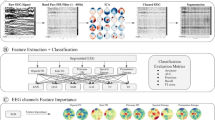Abstract
Future standardized system for distinguishing actual and artifactual magnetoencephalogram (MEG) data is an essential tool. In this paper, we proposed the quantitative parameters based on fractal dimension (FD) analyses in which the FD may convey different features before and after artifact removal. The six FD algorithms based on time-series computation, namely, box-counting method (BCM), variance fractal dimension (VFD), Higuchi’s method (HM), Kazt’s method (KM), detrended fluctuation analysis (DFA), and modified zero-crossing rate (MZCR) were compared. These approaches measure nonlinear-behavioral responses in the resting-state MEG data. Experimental results showed that the FD value of actual MEG was increased statistically in comparison with the artifactual MEG. The DFA and the HM present a best performance for analyzing simulated data and resting-state MEG data, respectively.
Access this chapter
Tax calculation will be finalised at checkout
Purchases are for personal use only
Similar content being viewed by others
Notes
- 1.
All subjects had normal brain function and data collection was approved by the Ethics Committee of Kanazawa University Hospital, all which were in accordance with the Declaration of Helsinki.
References
Mantini D, Franciotti R, Romani GL, Pizzella V (2008) Improving MEG source localizations: an automated method for complete artifact removal based on independent component analysis. NeuroImage 40:160–173
Mantini D, Penna SD, Marzetti L, de Pasquale F, Pizzella V, Corbetta M, Romani GL (2011) A signal-processing pipeline for magnetoencephalography resting-state networks. Brain Connectivity 1(1):49–59
Rong F, Contreras-Vidal JL (2006) Magnetoencephalographic artifact identification and automatic removal based on independent component analysis and categorization Approaches. J Neurosci Methods 157:337–354
Phothisonothai M, Tsubomi H, Kondo A, Kikuchi M, Yoshimura Y, Minabe Y, Watanabe K (2012) Linear and nonlinear features for automatic artifacts removal from MEG data based on ICA. In: 4th APSIPA ASC, IEEE press (to appear), Los Angeles, USA
Hornero R, Escudero J, Fernández A, Poza J, Gómez C (2008) Spectral and nonlinear analysis of MEG background activity in patients with Alzheimer’s disease. IEEE Trans Biomed Eng 55(6):1658–1665
Stam CJ (2005) Nonlinear dynamical analysis of EEG and MEG: review of an emerging field. Clin Neurophysiol 116:2266–2301
Delignieres D, Ramdani S, Lemoine L, Torre K, Fortes M, Ninot G (2006) Fractal analyses for ’Short’ time series: a re-assessment of classical methods. J Math Psychol 50:525–544
Phothisonothai M, Nakagawa M (2007) Fractal-based EEG data analysis of body parts movement imagery tasks. J Physiol Sci 57(4):217–226
Mandelbrot BB (1983) The fractal geometry of nature. WH Freeman, New York
Kinsner W (1994) Batch and real-time computation of a fractal dimension based on variance of a time series. Technical report, del946. University of Manitoba, Canada
Higuchi T (1988) Approach to an irregular time series on the basis of the fractal theory. Physica D 31:277–283
Katz MJ (1988) Fractals and the analysis of waveforms. Comput Biol Med 18(3):145–156
Peng CK, Buldyrev SV, Havlin S, Simons M, Stanley HE, Goldberger AL (1994) Mosaic organization of DNA nucleotides. Phys Rev E 49:1685–1689
Phothisonothai M, Nakagawa M (2008) A complexity measure based on modified zero-crossing rate function for biomedical signal processing. In: 13th international conference on biomedical engineering (ICBME2008), vol 23. Springer Press, Singapore, pp. 240–244
Kikuchi M et al (2011) Lateralized theta wave connectivity and language performance in 2- and 5-Year-Old children. J Neurosci 31(42):14984–14988
Kroese DP, Botev ZI (2013) Spatial process generation: lectures on stochastic geometry, spatial statistics and random fields. In: Schmidt V (ed) Analysis, modeling and simulation of complex structures, vol II. Springer (to appear), Berlin
Sabanal S, Nakagawa M (1995) A study of time-dependent fractal dimension of vocal sound. J Phys Soc Jpn 64:3226–3238
Acknowledgments
This research was supported by the Japan Society for the Promotion of Science (JSPS) and the Hokuriku Innovation Cluster for Health Science (MEXT Program for Fostering Regional Innovation).
Author information
Authors and Affiliations
Corresponding author
Editor information
Editors and Affiliations
Rights and permissions
Copyright information
© 2013 Springer-Verlag Berlin Heidelberg
About this paper
Cite this paper
Phothisonothai, M. et al. (2013). A Comparison of Actual and Artifactual Features Based on Fractal Analyses: Resting-State MEG Data. In: Yin, Z., Pan, L., Fang, X. (eds) Proceedings of The Eighth International Conference on Bio-Inspired Computing: Theories and Applications (BIC-TA), 2013. Advances in Intelligent Systems and Computing, vol 212. Springer, Berlin, Heidelberg. https://doi.org/10.1007/978-3-642-37502-6_146
Download citation
DOI: https://doi.org/10.1007/978-3-642-37502-6_146
Published:
Publisher Name: Springer, Berlin, Heidelberg
Print ISBN: 978-3-642-37501-9
Online ISBN: 978-3-642-37502-6
eBook Packages: EngineeringEngineering (R0)



